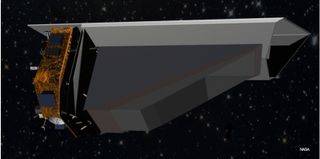No Launch for NASA's NEOCam Worries Asteroid Hunters

Amid the excitement for NASA's Discovery program announcement last week — which said that two new missions would fly by eight asteroids after launching in the 2020s — comes more difficult news for the other competitors in that proposal. Among them, an asteroid-hunting mission called NEOCam did not make the cut, although it will receive additional funding for a year.
NEOCam, also known as the Near-Earth Object Camera, was supposed to search for asteroids in infrared wavelengths, located at the L1 point, a stable gravitational region between the Earth and the sun. And the B612 Foundation, a private nonprofit organization that is focused on protecting Earth against dangerous asteroids, said it was disappointed the mission was not chosen.
"We urge the new administration to direct NASA or another involved agency to fund an asteroid-hunting infrared space telescope through an open solicitation rather than a science mission competition (e.g. Discovery), since the primary purpose would be for planetary defense and space development," B612 wrote in the statement.
RELATED: NASA to Send Mission to Metal Asteroid That Could Be Dead Planet's Core
NASA was directed by Congress in 2005 to find 90 percent of asteroids that are at least 140 meters (459 feet) in diameter by the year 2020. Multiple reports say the agency is behind on that search. NEOCam was designed to find two thirds of that population in the first four years after launch, according to their website.
B612 says NEOCam would be a complement to another telescope under construction, called the Large Synoptic Survey Telescope, which is expected to start operations in 2023. LSST would survey the sky over 10 years for several science applications, including looking for hazardous asteroids.
NEOCam also received the support of the National Research Council back in 2010, in its Defending Planet Earth report. The report says a space-based telescope would be an effective method to search for hazardous asteroids, and specifically mentions NEOCam as an example.
Get the Space.com Newsletter
Breaking space news, the latest updates on rocket launches, skywatching events and more!
Separately, B612 is working on an asteroid-hunting telescope of its own called Sentinel. It would orbit the sun in approximately the same orbit as Venus (which is closer to the sun than Earth). The telescope would look for objects as small as 40 meters (131 feet) in size, thought to be about the same size as the impactor that flattened a Siberian forest in Tunguska in 1908. B612 is in the process of raising funds for the mission, despite some setbacks.
RELATED: Step Aside Iron Man, NASA's Going to Explore a Strange Iron World
NASA is already looking for asteroids through its Near-Earth Object program, which partners with several surveys in the United States to share information. NASA also has an asteroid-hunting telescopic mission called NEOWise that is expected to finish operations this year, once its orbit brings it into an area with too much sunlight to conduct surveys.
The principal investigator of NEOWise, the Jet Propulsion Laboratory's Amy Mainzer, is also one of the proposers for NEOCam.
WATCH VIDEO: Why Do We Want to Capture an Asteroid?
Originally published on Seeker.
Join our Space Forums to keep talking space on the latest missions, night sky and more! And if you have a news tip, correction or comment, let us know at: community@space.com.

Elizabeth Howell (she/her), Ph.D., is a staff writer in the spaceflight channel since 2022 covering diversity, education and gaming as well. She was contributing writer for Space.com for 10 years before joining full-time. Elizabeth's reporting includes multiple exclusives with the White House and Office of the Vice-President of the United States, an exclusive conversation with aspiring space tourist (and NSYNC bassist) Lance Bass, speaking several times with the International Space Station, witnessing five human spaceflight launches on two continents, flying parabolic, working inside a spacesuit, and participating in a simulated Mars mission. Her latest book, "Why Am I Taller?", is co-written with astronaut Dave Williams. Elizabeth holds a Ph.D. and M.Sc. in Space Studies from the University of North Dakota, a Bachelor of Journalism from Canada's Carleton University and a Bachelor of History from Canada's Athabasca University. Elizabeth is also a post-secondary instructor in communications and science at several institutions since 2015; her experience includes developing and teaching an astronomy course at Canada's Algonquin College (with Indigenous content as well) to more than 1,000 students since 2020. Elizabeth first got interested in space after watching the movie Apollo 13 in 1996, and still wants to be an astronaut someday. Mastodon: https://qoto.org/@howellspace
